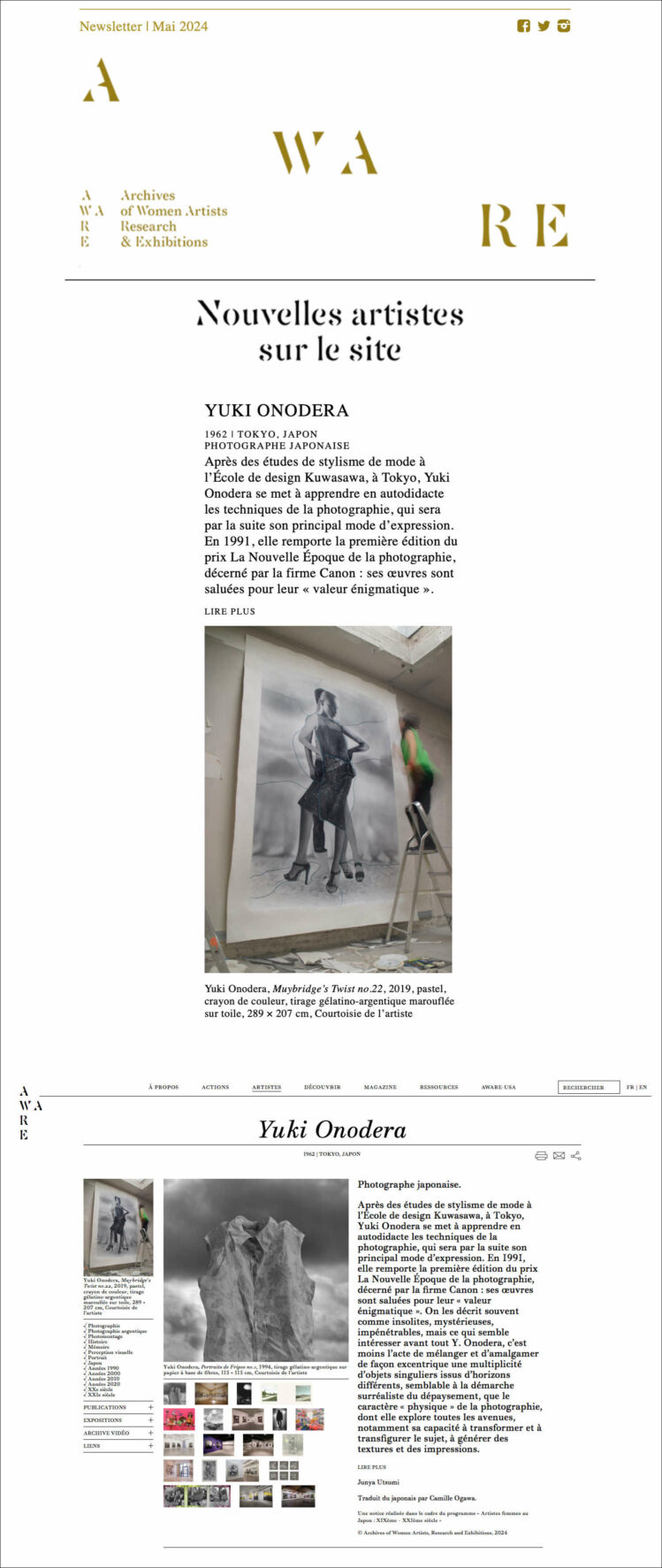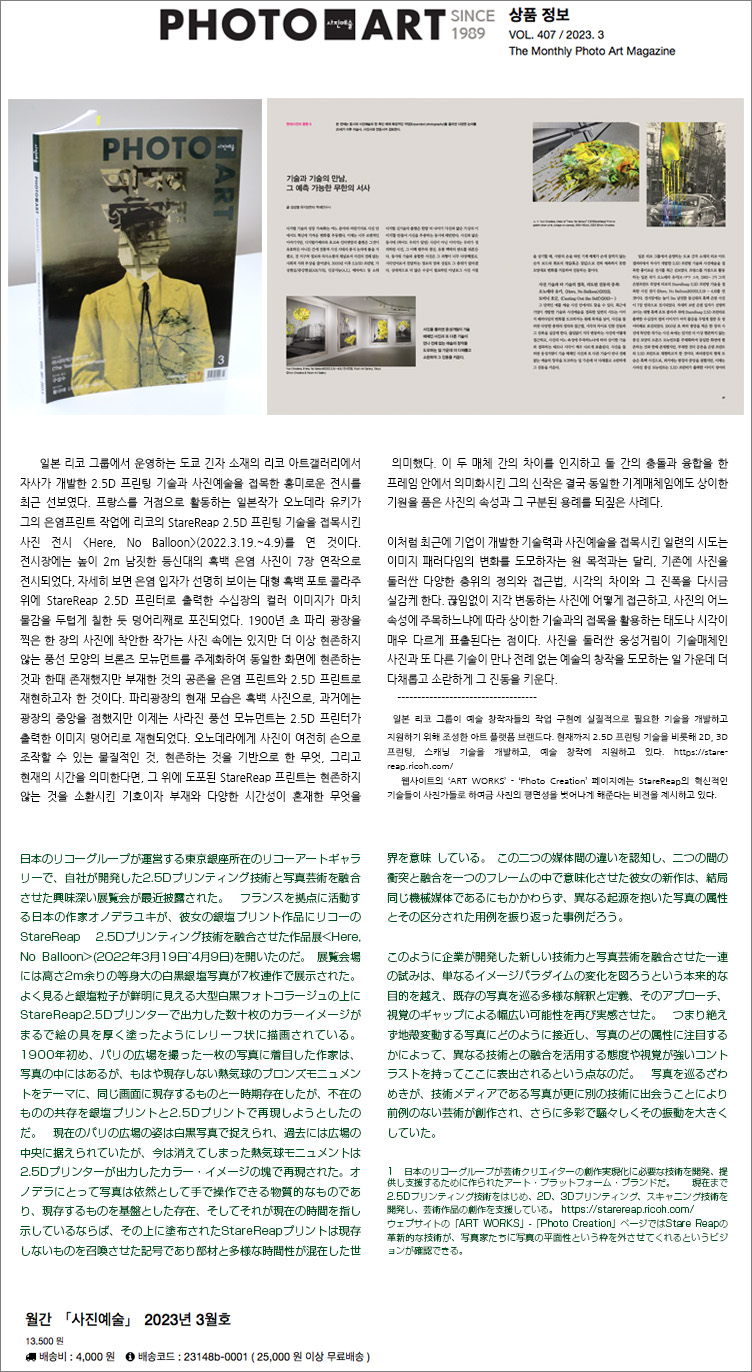AWARE : Archives of Women Artists, Research and Exhibitions
AWARE : Archives of Women Artists, Research and Exhibitions
Yuki Onodera
Photographe japonaise.Après des études de stylisme de mode à l’École de design Kuwasawa, à Tokyo, Yuki Onodera se met à apprendre en autodidacte les techniques de la photographie, qui sera par la suite son principal mode d’expression. En 1991, elle remporte la première édition du prix La Nouvelle Époque de la photographie, décerné par la firme Canon : ses œuvres sont saluées pour leur « valeur énigmatique ». On les décrit souvent comme insolites, mystérieuses, impénétrables, mais ce qui semble intéresser avant tout Y. Onodera, c’est moins l’acte de mélanger et d’amalgamer de façon excentrique une multiplicité d’objets singuliers issus d’horizons différents, semblable à la démarche surréaliste du dépaysement, que le caractère « physique » de la photographie, dont elle explore toutes les avenues, notamment sa capacité à transformer et à transfigurer le sujet, à générer des textures et des impressions.
Y. Onodera arrive à Paris en 1993, au moment où se tient l’exposition Dispersion de Christian Boltanski (1944-2021). Pour réaliser l’œuvre éponyme, C. Boltanski a empilé une grande quantité de vêtements usagés, voire déchirés, tel un monument dressé à la Shoah. Quand Y. Onodera vient admirer l’œuvre, elle remporte de sa visite, dans un sac prévu à cet effet, autant de vêtements qu’elle a pu, ce qui donne naissance à son tour à sa célèbre série Portraits de fripes (1994), dans laquelle chaque pièce est photographiée individuellement, dépliée et de face, en lévitation sur un fond représentant un ciel traversé de nuages vaporeux. Le voile gris recouvrant l’image souligne le contraste entre le premier plan et l’arrière-plan, et suggère la présence de celui ou celle qui devait porter ces habits. La texture du tissu est nettement rendue au premier plan, de façon quasi tangible, soulignant à la fois l’absence et la présence de son propriétaire, tandis que le flou du ciel lointain en arrière-plan évoque le temps qui passe inexorablement, au-delà de la finitude dudit propriétaire, ou peut-être l’incommensurable temps qui s’est accumulé sur ses épaules. L’artiste raconte que, pour chaque portrait, elle attendait de sentir que l’individu s’était évaporé dans l’air avant de prendre le cliché. La démarche vise à redonner vie à chaque pièce du monceau de vêtements et à utiliser la photographie comme un mécanisme capable d’évoquer les textures à partir de souvenirs générés, même si ceux-ci sont inconnus du spectateur ou de la spectatrice.
On ne peut combiner plusieurs caractères physiques dans une image que si on connaît la texture des éléments saisis par la photographie. Roland Barthes a théorisé que la photographie est avant tout le témoin ou la répétition de « ce qui a été », autrement dit une sorte d’« échec » de la réalité, plutôt que le portrait de ce qui nous apparaît. Y. Onodera applique ce principe dans plusieurs de ses séries pour construire une matérialité autre. Dans Comment fabriquer une perle (2000-2001), elle insère une bille dans l’appareil photo pour piéger la lumière et créer un effet d’ombre, donnant l’illusion qu’un étrange objet blanc flotte au-dessus d’une foule rassemblée le soir ; tandis que, dans Liquide, téléviseur et insecte (2002), le visuel d’un insecte capturé par l’appareil photo lors d’émissions télévisées est juxtaposé à un cliché de liquide renversé, peut-être de la peinture, pour former l’illusion de l’ombre de l’insecte. Transvest (2002) est un autre photomontage réalisé à partir d’images prises dans des magazines et des journaux pour composer une silhouette en contre-jour. Dans Le Onzième Doigt (2006- en cours), le visage des personnages est caché par une feuille ajourée comme de la dentelle qui se serait collée là lors du processus de création du photogramme, créant ainsi une couche supplémentaire à la scène qui a fait l’objet de la prise de vue. Dans Étude pour « Image à la sauvette » (2015- en cours), de la peinture acrylique a été appliquée sur le tirage : elle semble surgir de bouteilles en plastique déformées, qui sont en fait une combinaison de photographies et ne doivent leur reconnaissable existence transparente que grâce aux reflets de la lumière.
Outre ces distorsions créatives, qui mettent en évidence la manière dont la photographie opère et intègre plusieurs niveaux de caractère physique dans une même image, la taille du cliché final joue aussi un rôle important dans l’œuvre de Y. Onodera, qu’il s’agisse d’un grand ou d’un petit format, comme c’est clairement le cas dans Muybridge Twist (2014-en cours). Tout en se référant au photographe britannique Eadweard Muybridge (1830-1904), entré dans l’histoire avec ses instantanés décomposant le mouvement d’un cheval au galop ou de personnes en train de marcher, Y. Onodera réunit dans cette série différentes parties du corps humain, voire d’animaux, en une seule figure qui semble danser en se contorsionnant – d’où le terme twist du titre anglais. Plutôt que de montrer les séquences du mouvement du personnage, elle crée des sortes de sculptures déjantées dans des tirages plus grands que la taille humaine, des formats 300 ´ 200 cm. Au moment de faire son assemblage, elle agrandit les images qu’elle a découpées dans des magazines de mode et réalise des collages dans la taille voulue pour sa composition finale. Cette dimension joue un rôle déterminant en ce qu’elle confère à la création un écrasant sentiment de puissance qui s’abat sur le spectateur, tout en mettant en évidence en quoi un autre caractère physique de la photographie peut impacter le ressenti de l’œuvre.
Les récentes expositions personnelles de Y. Onodera sont l’occasion de présenter de nouvelles séries, notamment La Clairvoyance du hasard, au Centre de la photographie de Mougins en 2022, ou Here, No Balloons, à la Ricoh Art Gallery de Tokyo la même année. Citons comme rétrospectives monographiques majeures Yuki Onodera. Décalages en 2015 à la Maison européenne de la photographie, à Paris, Mille miroirs dans la forêt en 2014 à la Maison d’art Bernard Anthonioz, à Nogent-sur-Marne, La Photographie en apesanteur en 2011-2012 au musée Nicéphore Niépce, à Chalon-sur-Saône, Onodera Yuki : Into the Labyrinth of Photography au musée de la Photographie de la ville de Tokyo (TOP Museum) en 2010 ou encore Onodera Yuki au musée de la Photographie de Séoul en 2010. En 2011, Y. Onodera a été récompensée par le prix du ministère japonais de l’Éducation et de la Culture et par le prix du photographe japonais lors de la 27e édition du prix Higashikawa. Elle a également été lauréate du prix Nièpce Gens d’images en 2006 et du 28e prix Ihei Kimura en 2003.
Junya Utsumi
Traduit du japonais par Camille Ogawa.
Une notice réalisée dans le cadre du programme « Artistes femmes au Japon : XIXème – XXIème siècle »
© Archives of Women Artists, Research and Exhibitions, 2024









